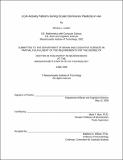LGN activity patterns during ocular dominance plasticity in vivo
Author(s)
Linden, Monica L. (Monica Loryn)
DownloadFull printable version (2.083Mb)
Alternative title
(cont.) These findings substantially alter the interpretation of previous studies and define the activity patterns that govern cortical plasticity in vivo. Furthermore, this work may have important implications for treatments of developmental disorders including ambylopia.
Other Contributors
Massachusetts Institute of Technology. Dept. of Brain and Cognitive Sciences.
Advisor
Mark F. Bear.
Terms of use
Metadata
Show full item recordAbstract
Perturbations of sensory experience in young animals are known to cause lasting changes in adult brain function. For example, monocular visual deprivation by lid closure (MC) leads to a loss of cortical responsiveness of the deprived eye and a concomitant visual impairment. This ocular dominance (OD) plasticity is a well-studied model of experience-dependent cortical plasticity. While much is known about the anatomical, physiological and biochemical changes that occur in primary visual cortex following OD plasticity, the input patterns that lead to these changes have not been characterized. Visual input travels from the retina through the dorsal lateral geniculate nucleus (dLGN) of the thalamus and then into visual cortex. Several models of the thalamic activity patterns which drive OD plasticity have been proposed, but the assumptions about the pattern and amount of input activity from thalamus to cortex during deprivation have not been experimentally validated. Therefore, we performed extracellular recordings from the dLGN of animals during periods of visual manipulation. Contrary to previous hypotheses, the present findings demonstrate that MC does not alter the overall firing rate of neural activity in the dLGN. Instead, MC alters the pattern of neural spike trains such that there is a decrease in simultaneous firing of neighboring neurons. Moreover, the elimination of visual input from the retina, a form of deprivation which does not lead to deprived-eye depression, leads to a dramatic increase in thalamic bursting. Additionally, there are subtle qualitative differences between dLGN activity in juveniles and adults during MC, and this may contribute to differences in OD plasticity with age.
Description
Thesis (Ph. D.)--Massachusetts Institute of Technology, Dept. of Brain and Cognitive Sciences, 2008. This electronic version was submitted by the student author. The certified thesis is available in the Institute Archives and Special Collections. "June 2008." Includes bibliographical references.
Date issued
2008Department
Massachusetts Institute of Technology. Department of Brain and Cognitive SciencesPublisher
Massachusetts Institute of Technology
Keywords
Brain and Cognitive Sciences.